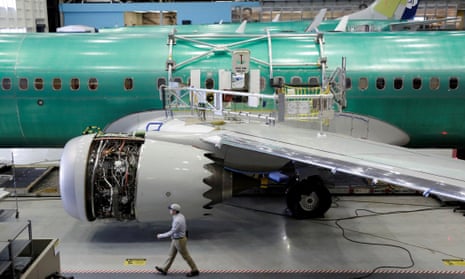A former Boeing manager says he would “absolutely not” fly on one of its 737 Max planes as the aircraft maker faces heightened scrutiny after a cabin panel blowout.
The company has been fighting to reassure regulators, airlines and passengers since a brand-new 737 Max 9 jet was forced into an emergency landing last month.
The dramatic incident during an Alaska Airlines flight – which prompted 171 Max 9 jets to be grounded for several weeks – has sparked the biggest safety crisis for Boeing since the crashes of two of its Max 8 jets, in 2018 and 2019, in which 346 people were killed.
“I would absolutely not fly a Max airplane,” Ed Pierson, a former senior manager on Boeing’s 737 program, told the LA Times. “I’ve worked in the factory where they were built, and I saw the pressure employees were under to rush the planes out the door. I tried to get them to shut down before the first crash.”
Pierson, who left Boeing in 2018 and is now executive director at the Foundation for Aviation Safety, expressed concern about the way in which regulators permitted the Max 9 to return to service last week.
He told ABC7 San Francisco: “If you had a new car that had a part fall off of it and you had to pull over to the side of the road, and then you went to the shop, and the mechanic said, ‘Hey, I’m finding some other things wrong with it, but here you go, ready to go get out on the road,’ you would probably have some questions about [whether] anything else [has] been missed. So that’s a concern that we’ve had.”
Although Boeing insists it has taken steps to strengthen its safety and quality processes in recent years, its chief executive, Dave Calhoun, acknowledged on Wednesday that the company has “more work to do” as it attempts to repair its reputation.
“I would tell my family to avoid the Max,” Joe Jacobsen, an engineer who worked at Boeing for a decade until 1995, also told the LA Times. “I would tell everyone, really.”
Jacobsen later worked at the Federal Aviation Administration, and is now an advocate for aviation safety.
Pierson described intense pressure faced by employees working on the Max production line. “Everybody can relate to schedule pressure in any job,” he told ABC7, “but when you’re building an airplane, you can’t afford to have those kinds of issues.”
Boeing declined to comment on Pierson’s remarks.
Last week, Stan Deal, president of the company’s commercial airplanes division, said winning back the confidence of “customers, our regulator and the flying public” was its long-term focus. “Frankly, we have disappointed and let them down,” he wrote to staff.
